Hair Transplant Cost in Turkey 2024

Hair transplant is a medical procedure increasing in popularity worldwide, with Turkey coming to the forefront particularly because of technological innovations and favorable cost policies. Under the title “Hair Transplant Cost in Turkey 2024,” we address many questions of interest regarding the hair transplant process: What is hair transplant and how is it performed, which techniques are used, how much do they cost, and what is the recovery process like? Turkey has become a global center in this field by offering the most advanced hair transplant techniques, such as FUE (Follicular Unit Extraction) and DHI (Direct Hair Implantation). The costs are quite competitive compared to the high-quality services provided, and the recovery process is faster and more comfortable thanks to modern techniques. This article aims to serve as a comprehensive starting point for those researching hair transplant options in Turkey in 2024. For detailed information and personalized consulting, feel free to contact us.
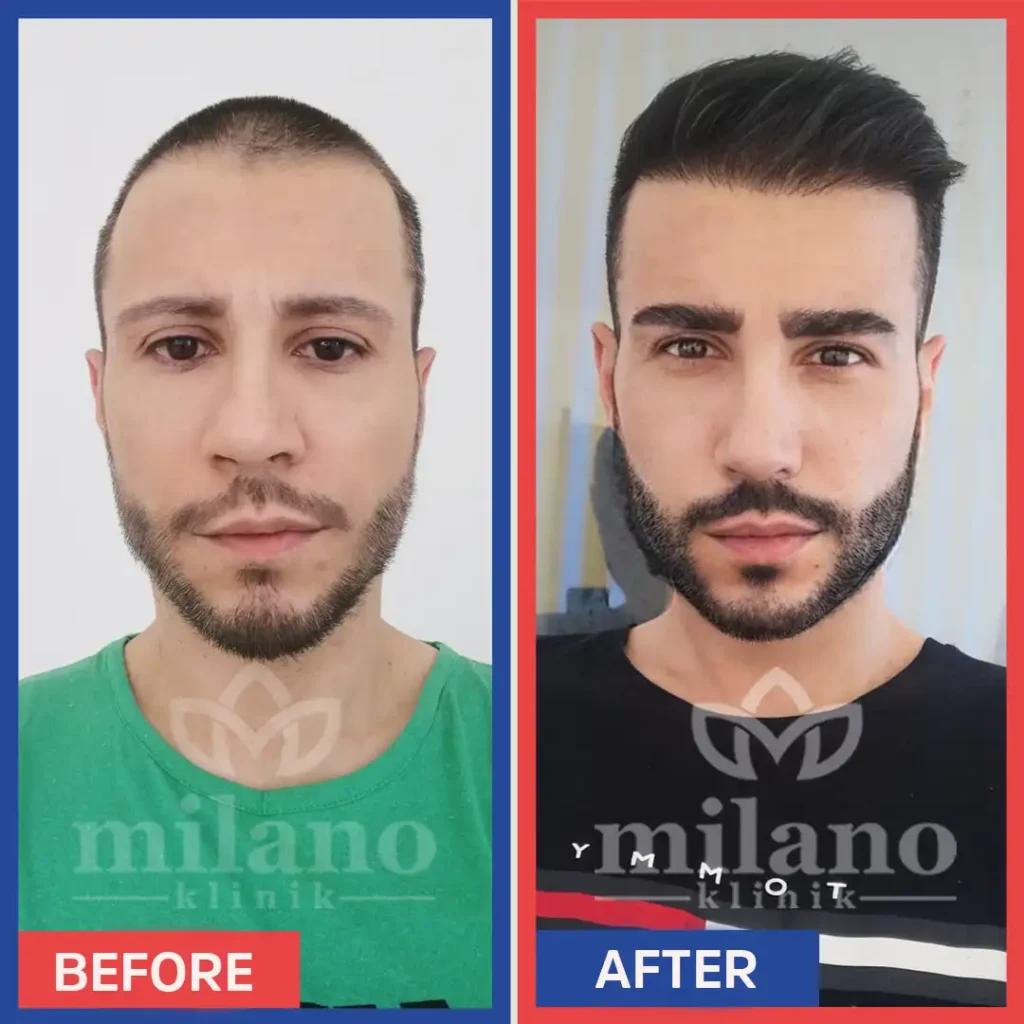
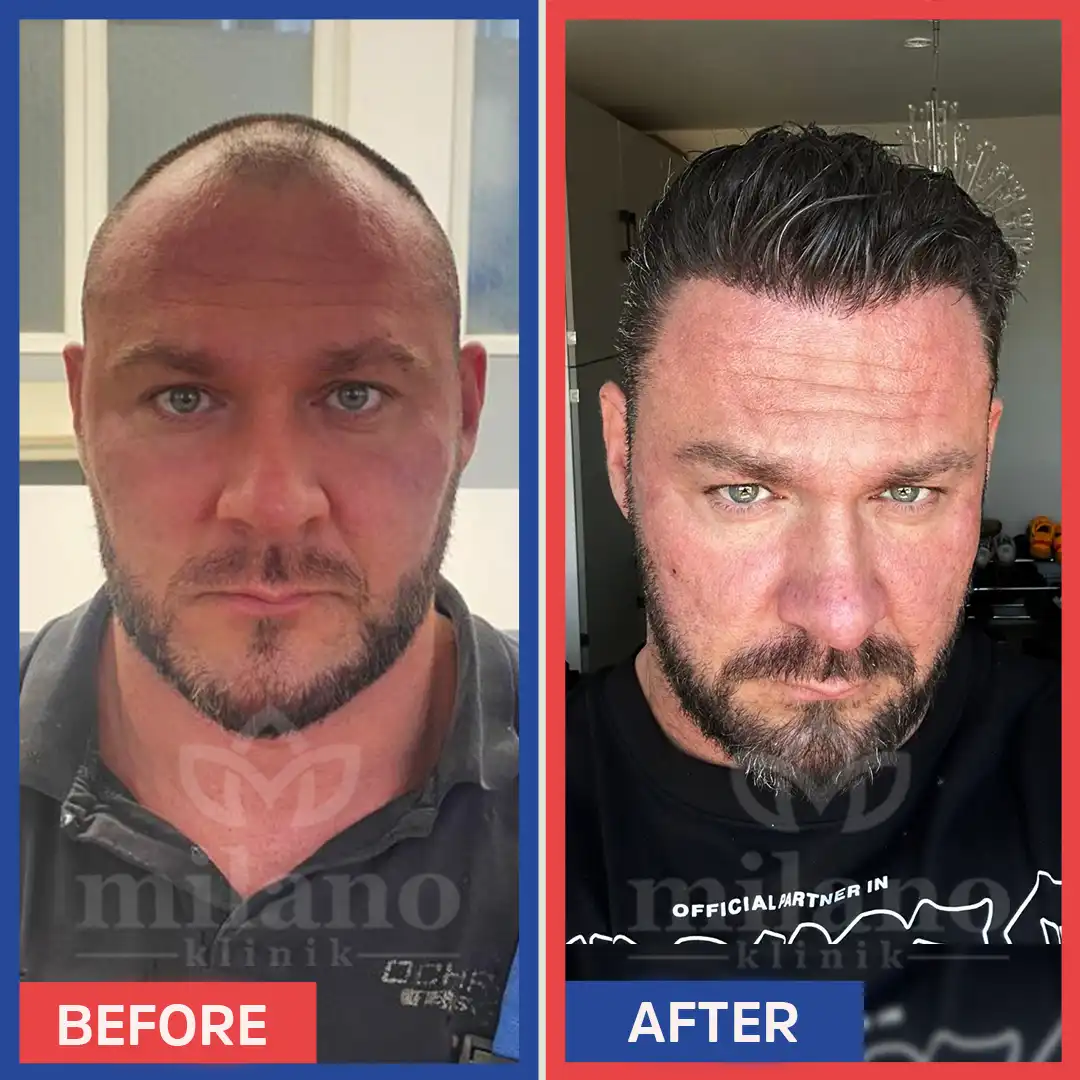
What is Hair Transplant Surgery?
Hair transplant surgery is an aesthetic and medical operation applied to individuals usually experiencing permanent hair loss. This method involves the transplantation of healthy hair follicles from the individual’s body to areas where the hair is thinning or has completely fallen out. Among modern hair transplant techniques are methods such as Follicular Unit Extraction (FUE) and Follicular Unit Transplant (FUT). The FUE method involves the direct transfer of individual hair follicles from the donor area to the balding areas; whereas, the FUT method includes removing a strip of tissue from an area with dense hair and transferring the follicles obtained from this tissue to the area where the transplant will be performed. Nowadays, the FUT method is almost never used.
How is a Hair Transplant Operation Performed?
A hair transplant operation is designed to provide a natural-looking and permanent solution for individuals experiencing hair loss or baldness. This detailed process involves transferring healthy hair follicles from the individual’s own body, usually from the back of the neck or other areas where hair is dense, to areas of baldness or thinning. Hair transplant is performed using two main techniques: Follicular Unit Extraction (FUE) and Follicular Unit Transplant (FUT).
Follicular Unit Extraction (FUE)
The FUE method is one of the most popular hair transplant techniques. In this method, hair follicles are extracted one by one from the donor area using a special instrument and then transplanted to the balding areas. FUE does not leave scars and has a relatively fast recovery process.
Follicular Unit Transplant (FUT)
The FUT method involves removing a strip of hairy scalp tissue from the donor area and transplanting hair follicles obtained from this tissue to the area where the transplantation will take place. FUT is usually preferred when transplanting hair over large areas. The recovery process may be a bit longer than FUE and can leave a small scar.
Stages of a Hair Transplant Operation
Preliminary Preparation: Assessing whether the patient is suitable for hair transplant and planning the operation.
Preparing the Donor Area: The donor area, from which hair follicles will be taken according to the chosen method, is numbed with local anesthesia.
Follicle Extraction: With the FUE method, hair follicles are carefully extracted from the donor area.
Creating Channels: Channels are made in the area where the hair follicles will be transplanted.
Follicle Transplant: The extracted follicles are carefully placed into the opened channels.
Recovery Process: After the operation, the patient’s recovery process begins, and care instructions are provided.
A hair transplant operation should be performed by experienced specialists in clinics equipped with the latest technology and techniques. A detailed consultation process to answer the patients’ questions before and after the operation is important. With proper care and follow-up, hair transplant results can provide significant aesthetic and psychological benefits to individuals.
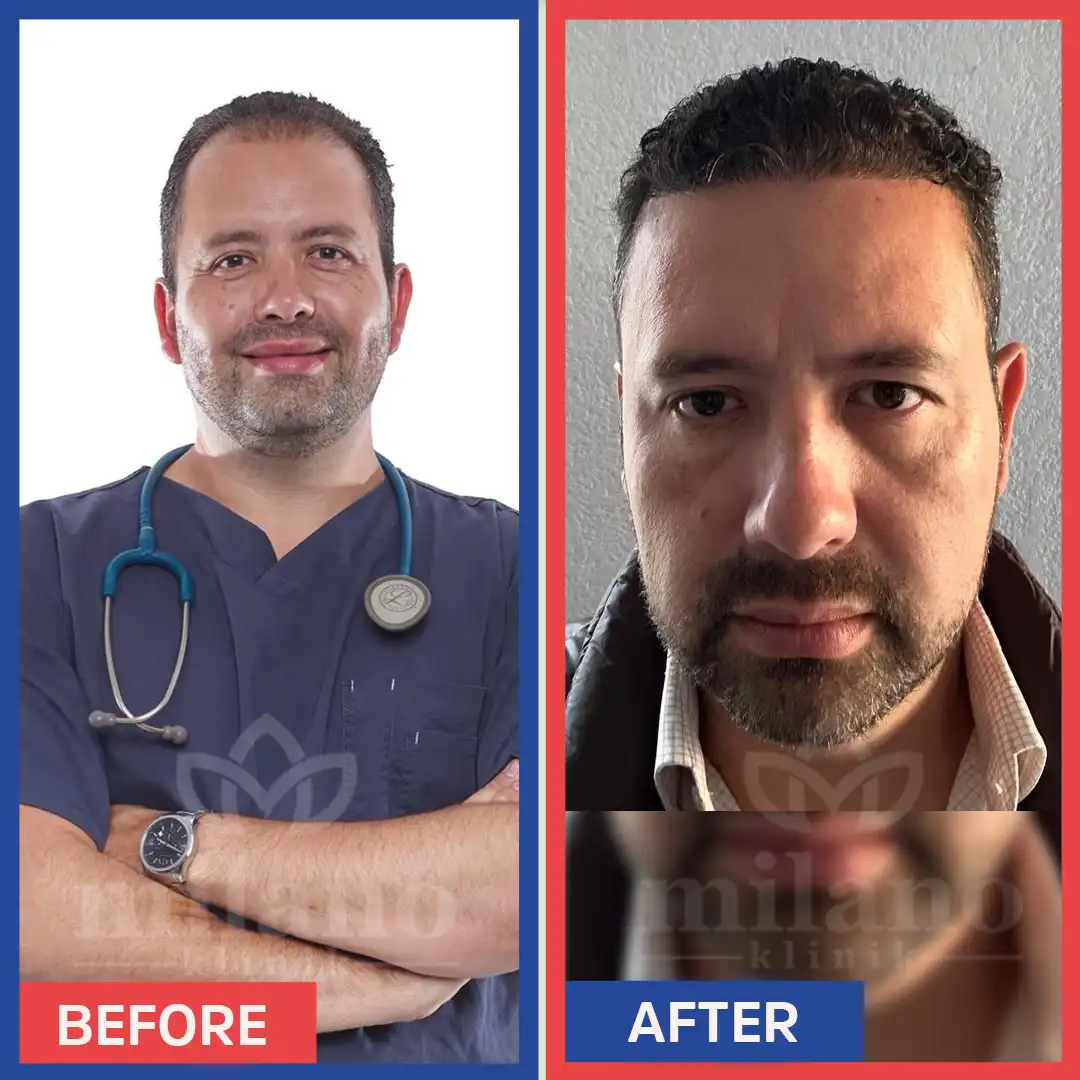
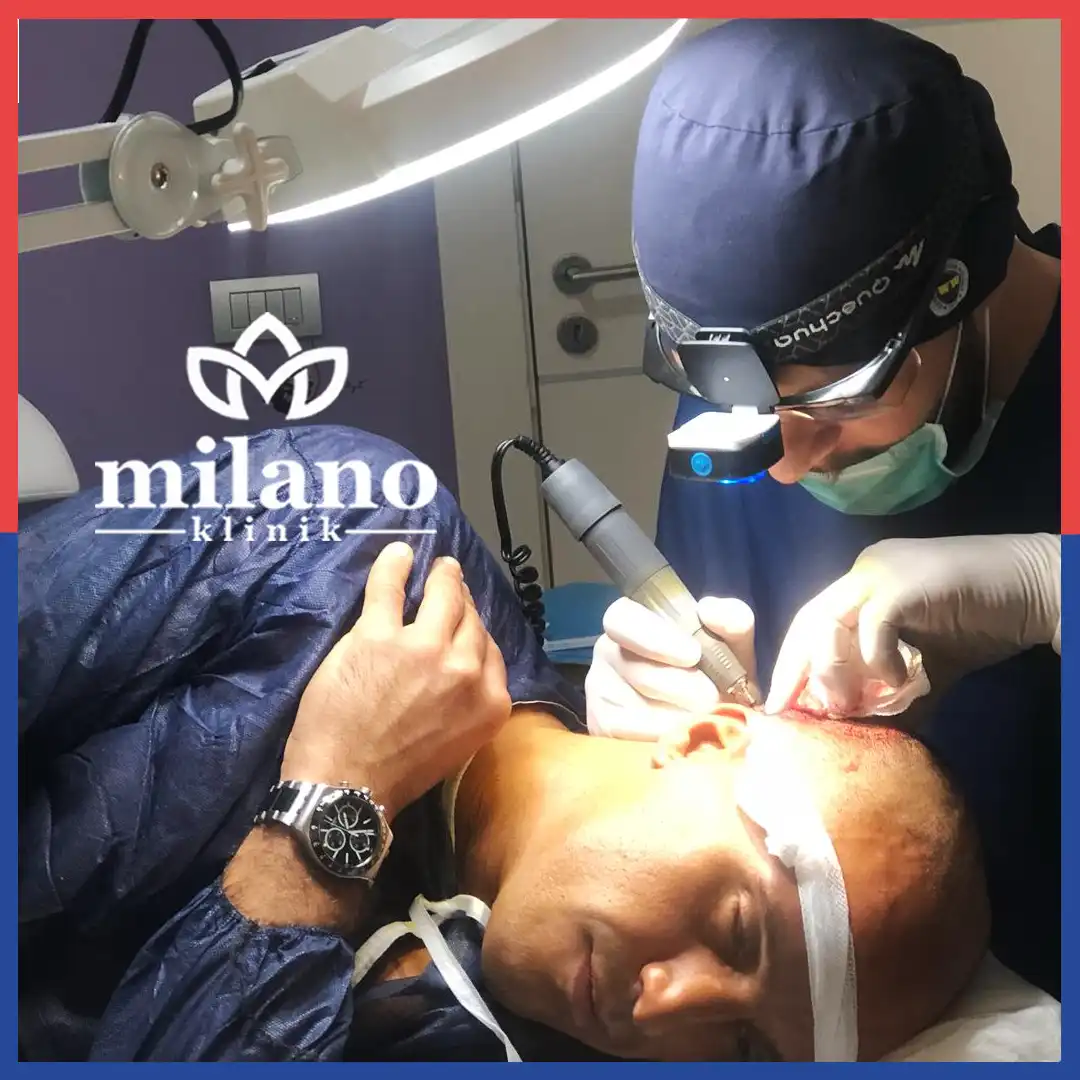
How Many Grafts Can Be Transplanted in One Session?
The number of grafts that can be transplanted in a single session of hair transplant operations varies depending on several factors. These factors include the patient’s hair density, the condition of the donor area, the transplant technique used, and the expectations of both the patient and the doctor. We explain in detail the question, “How Many Grafts Can Be Transplanted in One Session?”:
Determination of Graft Numbers
Personal Analysis: The patient’s hair structure, the quality of the donor area, and the size of the balding area are assessed.
Technical Capacity: The technique used (FUE, DHI, SAPPHIRE, STEM CELL, etc.) affects how many grafts can be transplanted within a certain session duration.
Graft Numbers and Session Configuration
Small Sessions: Suitable for small or localized hair loss areas, involving 500-1500 grafts. Typically lasts 4-6 hours.
Medium Sessions: Preferred for larger balding areas, involving 1500-3000 grafts. It can last 6-8 hours.
Large Sessions: Requires a denser transplantation covering large balding areas, involving 3000-4000 grafts. Can take a full day.
Mega Sessions: In some cases, especially for extensive balding areas, transplant of more than 4000 grafts may be necessary. There could be 5000 – 8000 grafts. This usually spans over two days.
Technical Limitations and Efficiency
FUE Technique: Individual follicle extraction takes more time, so large sessions may be planned over two days.
Variation According to the Patient’s Condition
Condition of the Donor Area: A healthy and dense donor area allows for a larger number of grafts to be transplanted.
Hair Density and Quality: Thin hair strands may require more grafts, while thicker strands can provide a denser look with fewer grafts.
Health and Healing Factors
The Overall Health of the Patient: Health conditions and healing capacity may affect the size of the operation.
Post-Operative Care: Larger sessions may require a more careful post-operative care routine.
Conclusion
The number of grafts that can be transplanted in a single session varies widely based on individual needs and technical possibilities. When planning a hair transplant, all these factors should be considered and a detailed preliminary consultation should be conducted between the patient and the doctor. This process is crucial to achieve the expected results.
Hair Transplant Techniques and Innovations
Hair transplant provides effective solutions for individuals suffering from hair loss and baldness, thanks to evolving technologies and innovative methods. Under the title “Hair Transplant Techniques and Innovations,” we will discuss the latest developments, the most popular techniques, and significant innovations in the hair transplant process.
Classic Hair Transplant Techniques
Follicular Unit Transplant (FUT): The FUT method involves taking a strip of hairy scalp from the donor area, dividing it into individual follicular groups under a microscope, and transplanting these to the bald areas. This method allows for transplant over large areas but can leave scars.
Follicular Unit Extraction (FUE): FUE involves the extraction of individual hair follicles from the donor area and their transplant to bald areas. It does not leave scars and has a shorter recovery time.
Innovative Hair Transplant Techniques
Direct Hair Implantation (DHI): DHI uses a special pen (Choi pen) to directly implant hair follicles into the balding area. This method offers advantages in terms of a more natural look and increased implant density.
Sapphire FUE: Instead of traditional steel tips used in the FUE technique, sapphire tips are utilized. Sapphire tips provide less trauma and a faster recovery process.
Robotic Hair Transplant: Hair transplant using robot technology offers more precise follicle extraction and implantation possibilities. This method provides a level of precision and speed that cannot be achieved by human hands.
Innovations and Developments
Laser-Assisted Hair Transplant: Laser technology is used in hair transplant operations to accelerate the healing process and improve the recovery of the implantation area.
PRP (Platelet Rich Plasma) Therapy: PRP treatment is applied before and after hair transplantation accelerates the healing process and promotes healthier growth of hair follicles.
Stem Cell (Stem Cell) Therapy: Stem cell therapy used in conjunction with hair transplant helps in the regeneration of hair follicles and improves the quality of hair.
Conclusion
Hair transplant techniques and innovations are offering more effective and permanent solutions to hair loss problems, thanks to continuously developing medical technologies. Each technique and innovation provides advantages for different needs and expectations.
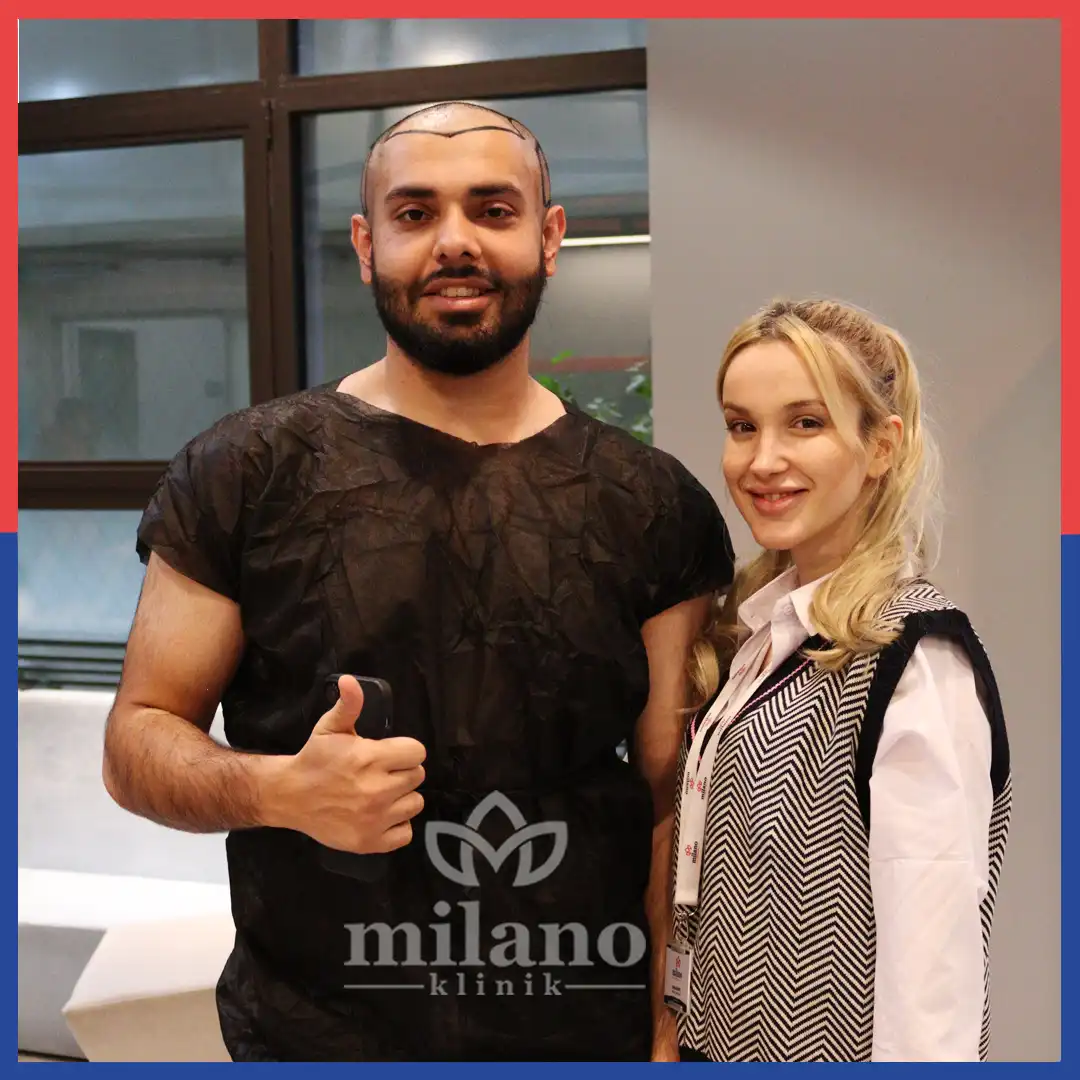
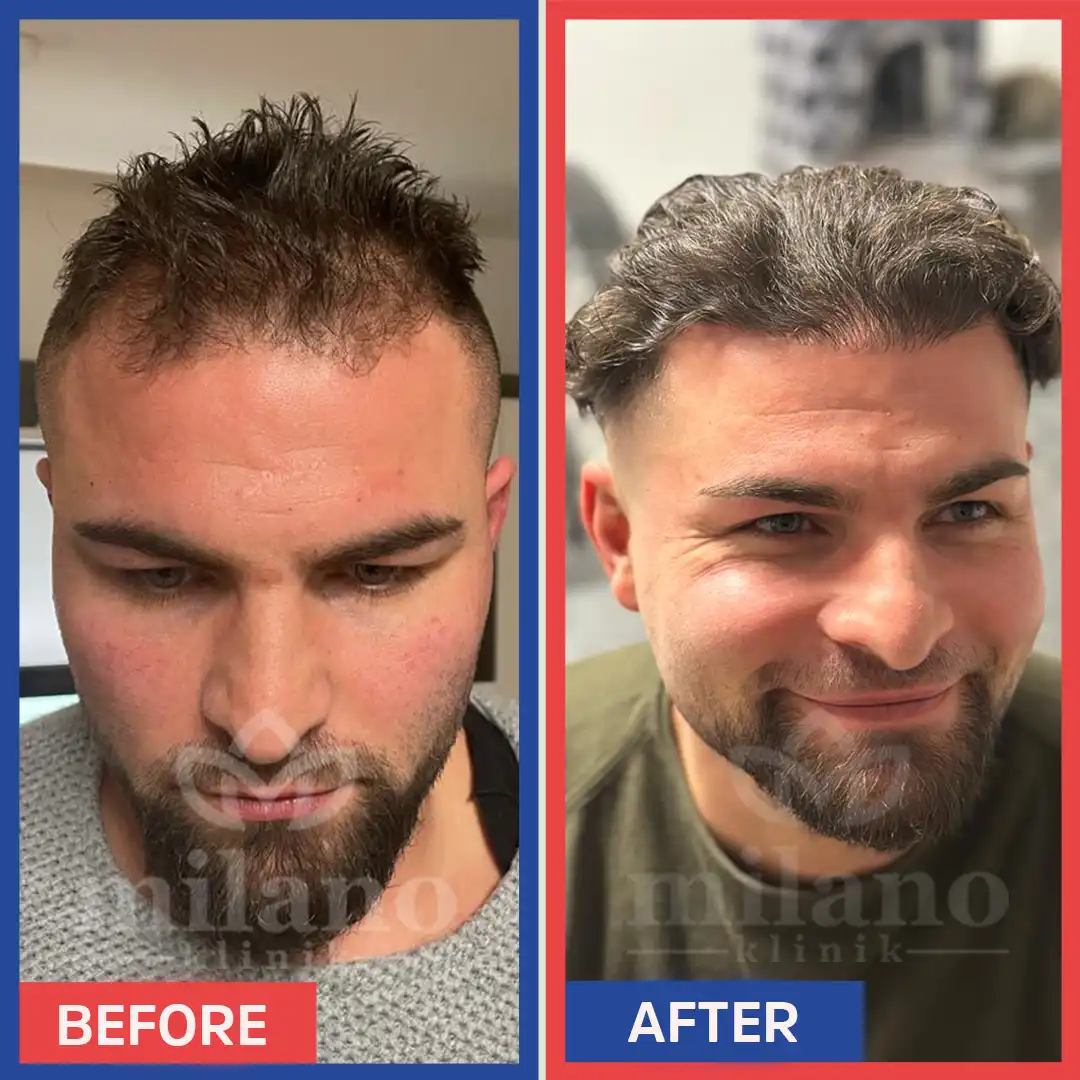
Unshaven Hair Transplant
Unshaven hair transplant is an advanced hair transplant method preferred by individuals who wish to quickly return to their professional life or immediately achieve an aesthetically pleasing appearance after the operation. This method eliminates the need for completely shaving the head during the hair transplant process, offering a more comfortable recovery period for individuals. Unshaven hair transplant typically employs the Follicular Unit Extraction (FUE) technique in harmony with the DHI technique. This method allows for the direct transfer of hair follicles from the donor area to regions showing thinning or loss. This approach is especially favored by women. Only a small area in the donor region is shaved, and grafts are extracted from there. These grafts are then transferred to the area to be transplanted. The entirety of the hair is not shaved; only a small area from the donor region is.
Advantages of the Unshaven Hair Transplant Method
Aesthetic Appearance: The ability to return to a normal appearance immediately after surgery allows for uninterrupted continuation of social and professional life.
Comfortable Recovery Process: Not shaving the hair provides extra comfort during the recovery process and enables the individual to return to their daily life immediately.
Hair Transplant and Beard Transplant
Hair transplant and beard transplant are among the popular operations aimed at improving aesthetic and personal appearance. Many individuals, desiring increased density and fullness in both their hair and beard, wonder whether these two procedures can be performed together. The short answer is yes, hair transplant and beard transplant operations can be carried out during the same period or at times close to each other. The planning and execution of these two procedures together depend on several important factors.
Suitability and Planning
Personal Assessment: A detailed dermatological and aesthetic evaluation of the individual who will undergo hair and beard transplant is required. This assessment covers factors such as the adequacy of the donor area, the density of hair and beard, and the overall health condition.
Planning: For both operations to be performed simultaneously, it is important to have a suitable donor area and ensure an adequate number of grafts can be provided. At the same time, the patient must consider the necessary recovery time for both procedures.
Technical Approach
FUE (Follicular Unit Extraction): This is the most commonly used method for both hair and beard transplant. This technique makes it possible to perform hair and beard transplant in the same period.
Operation Duration: If the donor area is sufficient and the planning is done correctly, hair and beard transplant can be carried out a few days apart or, in some cases, on the same day.
Advantages and Considerations
Time Savings: Performing both operations together saves recovery time and allows aesthetic improvements to be completed more quickly.
Comprehensive Change: Aesthetic changes in the hair and beard area provide significant improvements in the individual’s facial expression and overall appearance.
Recovery Process: Having both procedures done at the same time may require extra care and attention during the recovery process. It is important for patients to strictly follow the necessary instructions during recovery.
Conclusion
Hair transplant and beard transplant procedures can be performed together with proper planning and a professional approach. Combining these two operations offers advantages in terms of time and cost, while also making significant contributions to the overall aesthetic appearance.

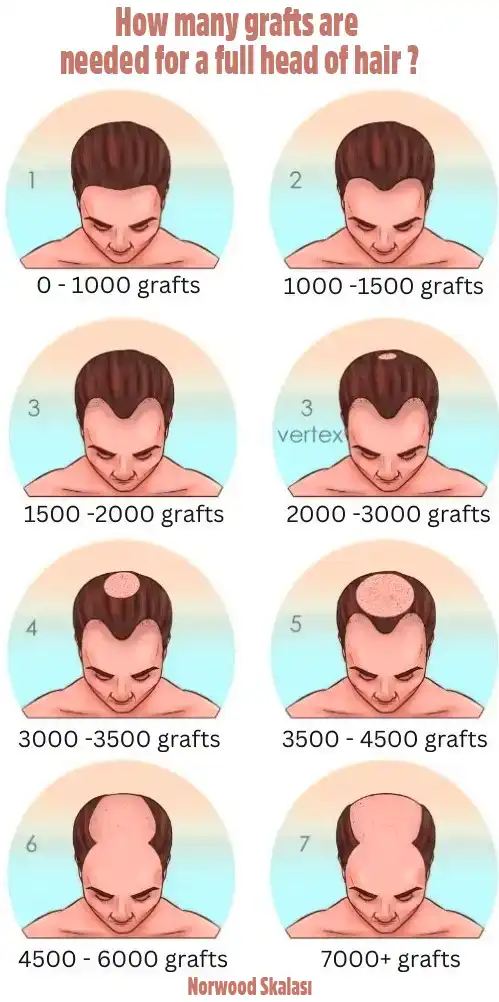
When should Hair Transplant be Done?
The timing for undergoing hair transplant can vary from person to person and requires careful evaluation. Under the topic “When should Hair Transplant be Done?”, we will extensively discuss the factors and key points that help determine the suitable timing for hair transplantation.
Stage of Hair Loss
Progression of Hair Loss: Hair transplant should ideally be done once hair loss has stabilized. Generally, hair transplant is recommended once the hair loss process has completely ceased and the condition has stabilized.
Norwood Scale: The Norwood Scale can be used to determine the degree of hair loss. According to this scale, individuals with moderate to severe hair loss are more suitable candidates for hair transplant.
Age Factor
Young Patients: Individuals experiencing hair loss at a young age are advised to wait until the pattern of hair loss is fully determined before undergoing hair transplant. Hair transplant at an early age might necessitate additional procedures in the future.
Mature Patients: Individuals whose pattern of hair loss has stabilized and are older may be at a more appropriate time for hair transplant.
Health Condition and Medication Use
Health Condition: A suitable general health condition is required for hair transplant. Individuals with chronic illnesses or those taking certain medications should consult with their doctors prior to the operation.
Personal Expectations and Lifestyle
Evaluation of Expectations: It is important to have realistic expectations about the outcomes and the process of hair transplant.
Lifestyle Changes: After hair transplant, lifestyle changes may be necessary to adapt to the recovery process and maintain the results.
Considering these factors can help in making an informed decision about the timing of hair transplant, ensuring that it is conducted at the most opportune moment for effective and satisfactory outcomes.
How Long Does a Hair Transplant Take?
The duration of a hair transplant varies depending on a number of factors. These factors include the size of the area to be transplanted, the hair transplant technique used, the patient’s hair density, and the planned number of grafts (hair follicles) for transplant. Factors affecting the duration include:
Hair Transplant Duration
Follicular Unit Extraction (FUE): The FUE method involves individually extracting and transplanting hair follicles. This technique can be performed with varying amounts, ranging from 500 to 2500 grafts, and typically lasts between 4 to 8 hours. Larger sessions may be spread over two days.
Duration Based on Graft Number
Small Number of Grafts: A small transplant procedure involving 500 to 1000 grafts can typically take between 4 to 6 hours.
Medium Number of Grafts: Transplanting 1000 to 2000 grafts can take between 6 to 8 hours.
High Number of Grafts: Transplanting 2000 to 5000 grafts can take up to 8 hours. Transplanting 5000 to 8000 grafts may sometimes be planned over two days.
Stages of the Hair Transplant Process
Preparation and Consultation: The hair transplant process begins with the patient’s initial evaluation and consultation. Although this stage is not directly included in the overall duration, it is important for planning.
Anesthesia Application: Local anesthesia is applied before the procedure and takes about 30 minutes.
Graft Extraction: Depending on the chosen technique, the extraction of grafts can take between 2 to 4 hours.
Channel Opening and Graft Implantation: Opening channels in the area to be transplanted and placing the grafts cover a significant part of the total duration.
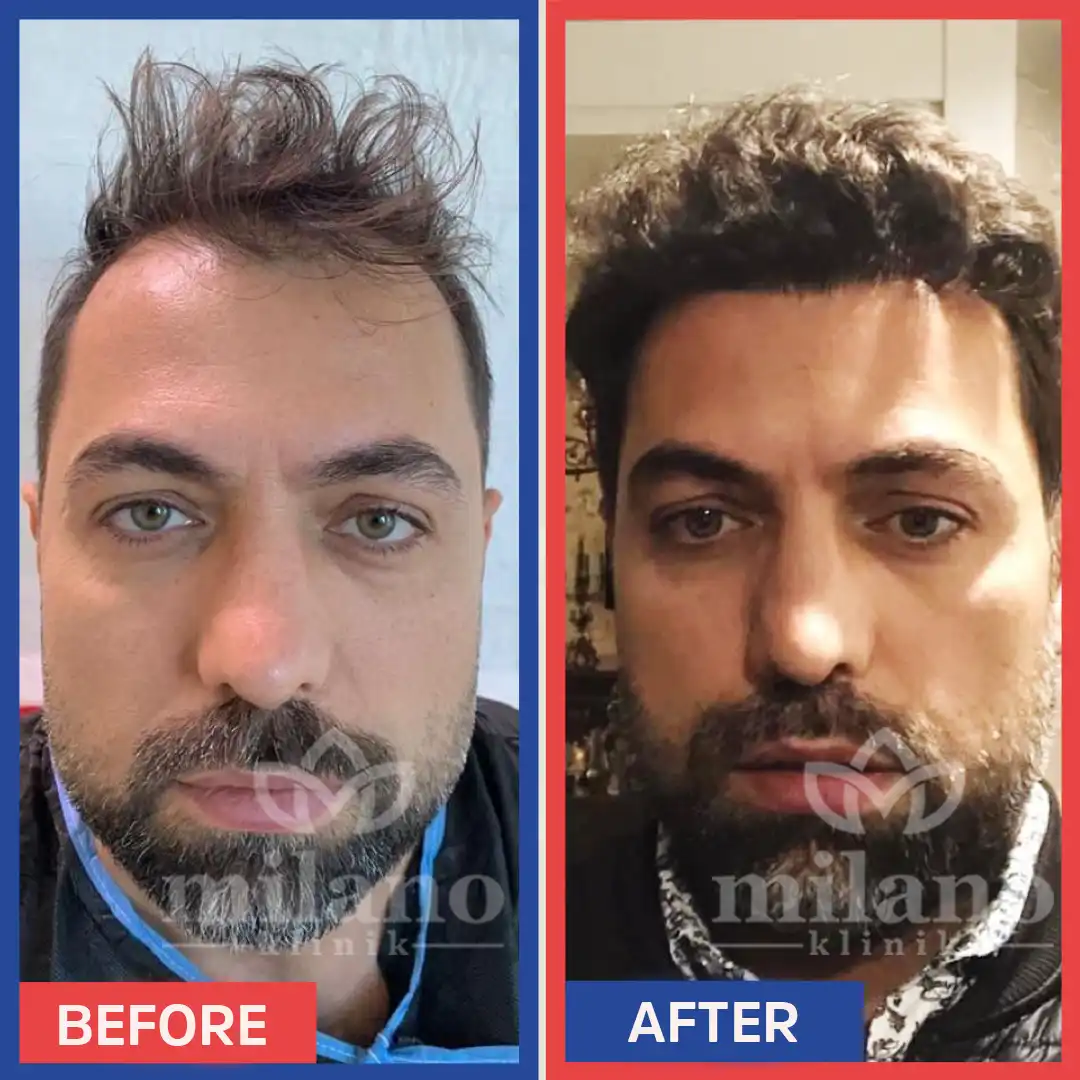
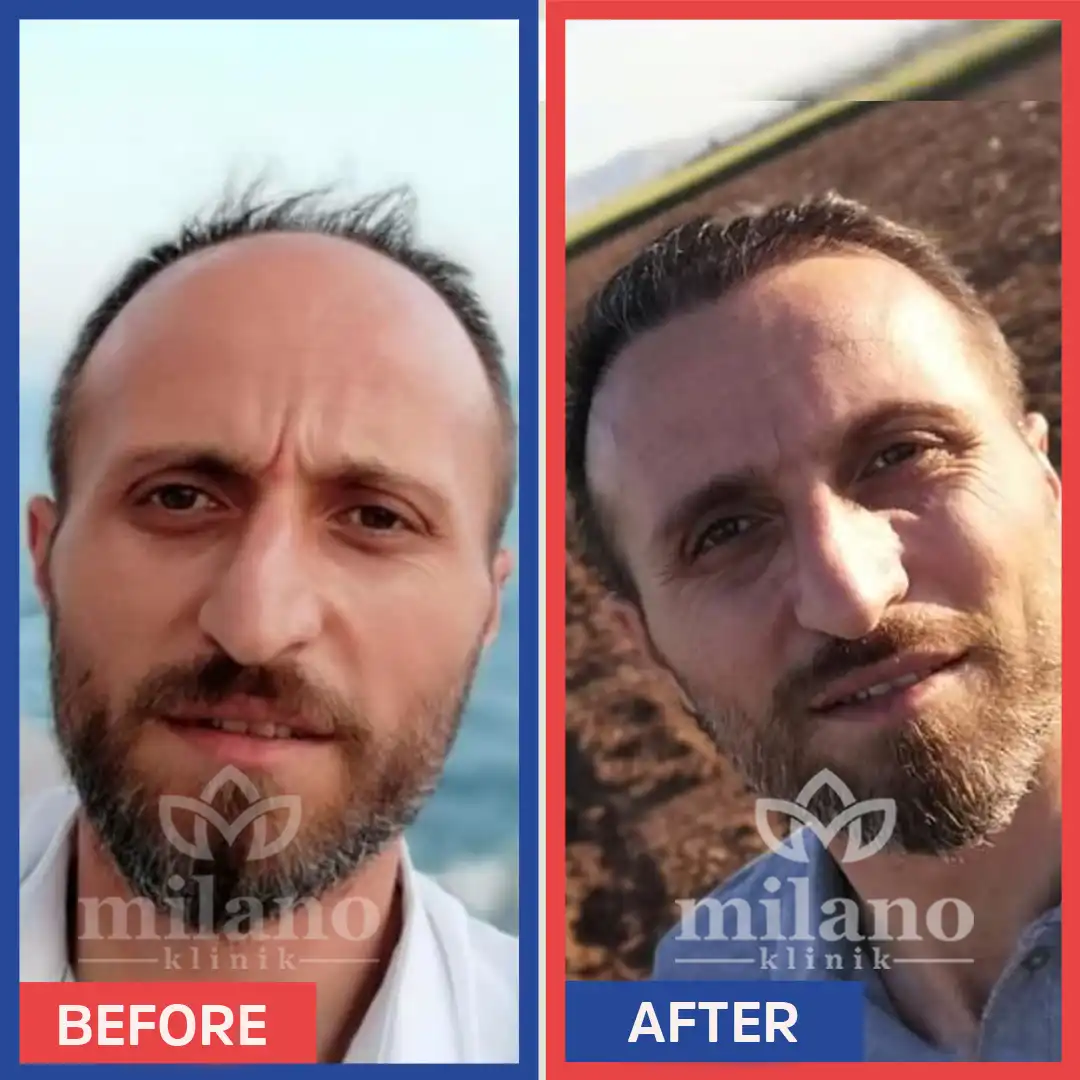
Hair Transplant Areas
With the advancements in medical techniques and innovations in the field of aesthetic surgery, hair transplant is no longer limited to addressing baldness and thinning on the scalp. It can also be applied to facial areas. Here are the primary regions where hair transplant can be performed:
Scalp
Front Hairline: Hair transplant is frequently used to correct a receding hairline and provide a younger appearance.
Crown Area: Transplanting hair to the thinning or bald crown area offers a fuller look.
Vertex Area: Transplantation in the area between the top of the head and the back, addressing thinning in this region.
Facial Area
Beard and Mustache: Beard and mustache transplant is chosen to fill in sparse areas, close gaps in the beard or mustache, and achieve a fuller facial hair appearance.
Eyebrows: Eyebrow transplant thickens sparse eyebrows or provides a permanent solution to areas experiencing eyebrow loss.
Preparation Before Hair Transplant Surgery
A successful hair transplant process is directly related to comprehensive preparations made before the operation. Paying attention to the steps for “Preparation Before Hair Transplant Surgery” not only enhances the efficiency of the operation but also accelerates the recovery process. Here are the important points to consider in the preparation process before hair transplant:
Hair Transplant Consultation
Detailed Health Check: Before the hair transplant, you may need to undergo a health check to assess your general health condition.
Setting Expectations: Establish a clear dialogue with your hair transplant specialist regarding your expectations.
Reviewing Health Status
Review of Chronic Diseases: It’s important for individuals with chronic diseases, such as heart disease or diabetes, to consult with their doctors before the hair transplant operation.
Medication Usage: Before the hair transplant, the use of certain medications, like blood thinners, may need to be temporarily discontinued. This should be done according to your doctor’s guidance.
Lifestyle Changes Before the Operation
Smoking and Alcohol Use: Smoking and alcohol can negatively affect the recovery process, so it’s recommended to quit these habits at least a week before the operation.
Preparations on the Day of the Operation
Wearing Comfortable Clothing: On the day of the operation, choose clothes that are easy to put on and take off and are comfortable.
Preoperative Nutrition: Depending on your doctor’s recommendations, you may need to fast for at least 8 hours before the operation. (This depends on the specifics of your procedure and anesthesia; please consult with your healthcare provider.)
Planning for Post-Operation
Planning for the Recovery Process: It’s important to plan for rest and to protect the operation area for several days after the operation.
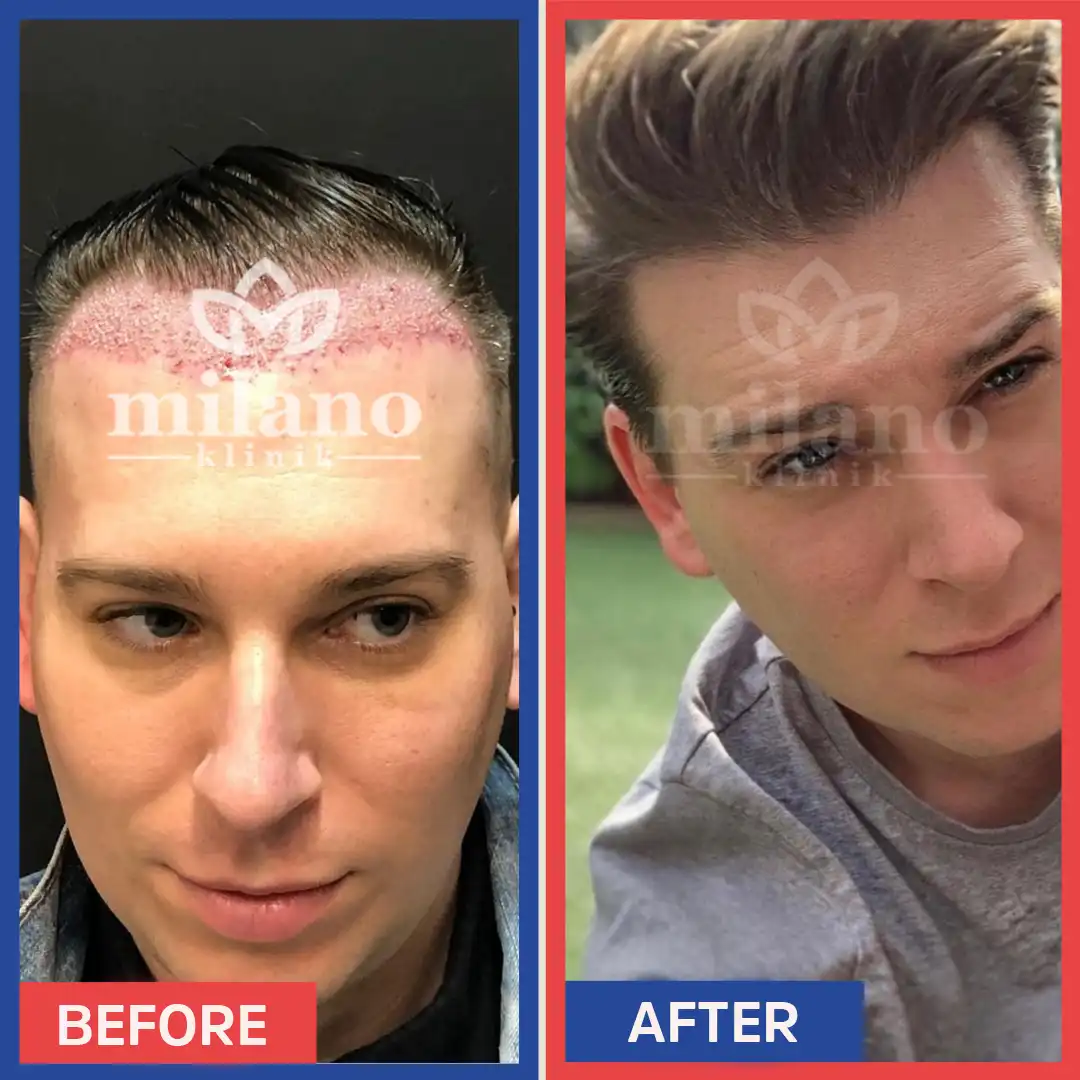
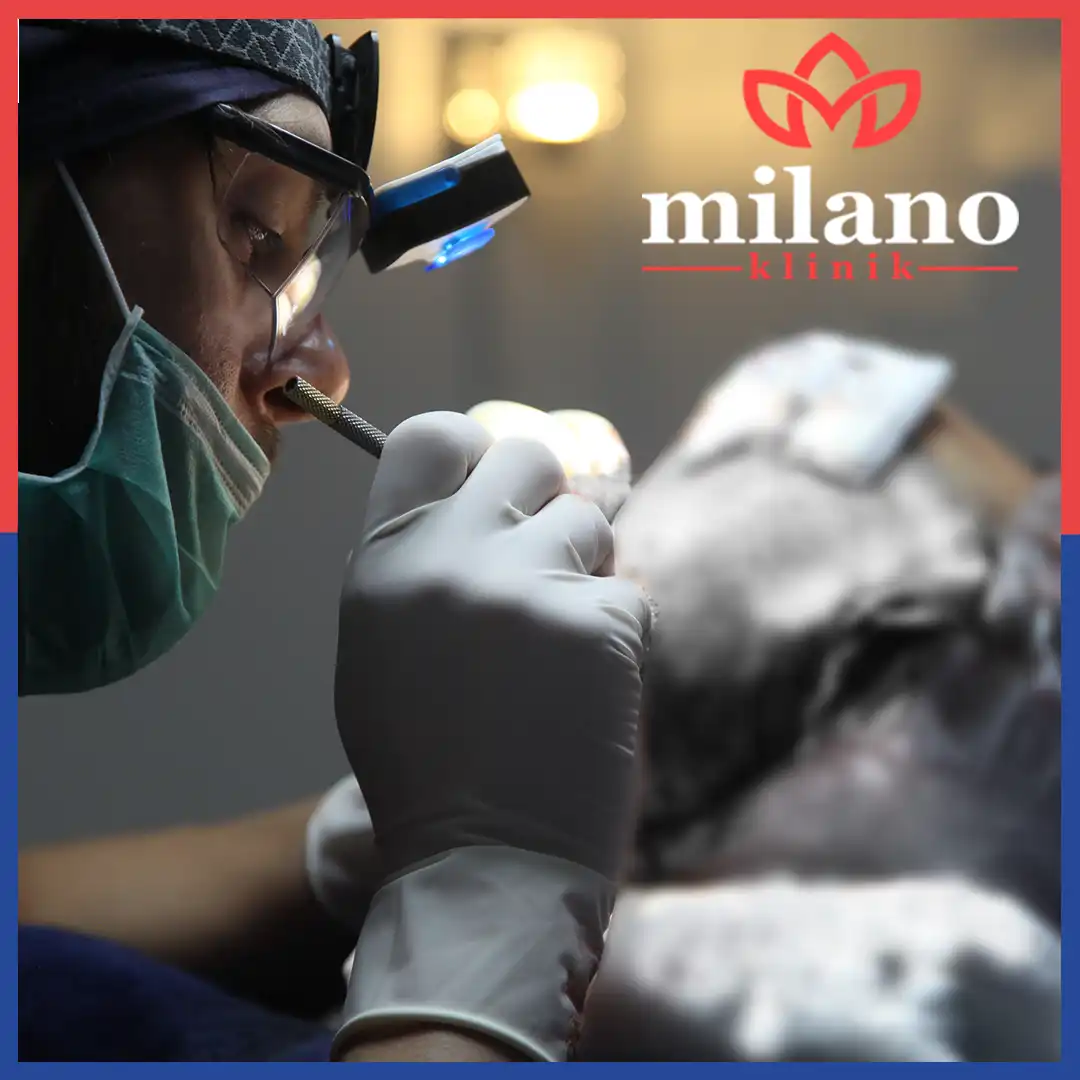
Hair Transplant Process: Operation Day!
The hair transplant process is a journey that starts with correct planning and preparation and continues until the day of the operation. Under the title “Hair Transplant Process: Operation Day!” we’ll delve into the actions to be taken, expectations, and important points to be aware of in detail on the day the hair transplant operation is performed.
Preparations the Day Before Operation
A Good Night’s Sleep: Getting a good night’s sleep the night before the operation prepares the body and mind for the procedure.
Eating: In some cases, you may be asked to fast before the operation, so follow your doctor’s instructions.
Choosing Comfortable Clothing: Wear comfortable clothing that is easy to take off and put on when coming to the operation.
On the Day of Operation
Clinic Registration and Final Preparations:
Upon arrival at the clinic, your registration processes are completed, and final evaluations are made before the operation.
You will be informed about the type of anesthesia (local or sedation) and the operation plan.
Preparation of the Donor Area:
The donor area selected for hair transplantation is very important for the success of the operation. This area is prepared for the extraction of hair follicles, and local anesthesia is applied if necessary.
Follicle Extraction and Preparation:
Using the most commonly used method, FUE (Follicular Unit Extraction), hair follicles are extracted one by one. The extracted follicles are carefully examined and prepared for transplantation.
Preparation of the Transplantation Area and Follicle Implantation:
The area to be transplanted is determined, and small channels are opened in this area for the placement of follicles. Hair follicles are implanted according to the predetermined pattern and density.
Post-Operation Initial Evaluation and Instructions:
After the operation is completed, the transplant area is carefully bandaged.
You will be informed about the recovery process and what needs to be followed.
Postoperative Considerations
Recovery Process: The recovery process after a hair transplant can vary from person to person. Following your doctor’s recommendations ensures the process is successful.
Care and Follow-ups: The post-transplant care routine and scheduled follow-up appointments are important for the long-term success of the operation.
Post-Hair Transplant Recovery Process
The recovery process following a hair transplant operation encompasses a period significant for both physical and aesthetic changes. Under the title “Post-Hair Transplant Recovery Process,” we will thoroughly examine the changes and expectations from the first month to the end of a year post-operation. Understanding the stages of post-transplant healing and hair growth helps in comprehending the natural progression of the process and managing expectations.
1st Month: Healing and Initial Changes
First Week: In the initial days post-operation, slight swelling and redness can be observed in the transplanted and donor areas. This is normal and typically subsides within a week.
Scabbing: Small scabs in the transplanted areas begin to shed in the weeks following the operation. Adherence to hair washing instructions is crucial.
Shock Loss: Within the first month post-operation, some of the transplanted hair follicles may shed. This is a normal part of the process and a prerequisite for permanent hair growth.
2nd-3rd Month: Shock Loss Completion and Waiting Period
Shock Loss Completion: By the end of the second month, the shock loss process generally concludes.
Waiting Period: This is a waiting period for the growth of transplanted hair follicles. Significant hair growth may not be observed during these months.
4th-6th Month: Initiation of Hair Growth and Increased Density
Hair Growth: Starting from the third month, new hairs begin to grow from the transplanted hair follicles.
Increase in Density: Between the fourth and sixth months, a noticeable increase in hair density occurs. The hair becomes thicker and healthier.
7th-9th Month: Density and Natural Appearance
Hair Maturation: Starting from the seventh month, the hair further thickens and gains a more natural appearance.
Fullness: By this period, a majority of the transplanted hairs have emerged, achieving fullness close to the pre-hair loss appearance.
10th-12th Month: Clarification of Results
Final Evaluation: By the end of the year, the results of the hair transplant become largely clear. The final outcomes of the hair transplant operation are assessed during this period.
Doctor Check-ups: In this period, you can have your final consultation appointments with your doctor to evaluate the overall process.
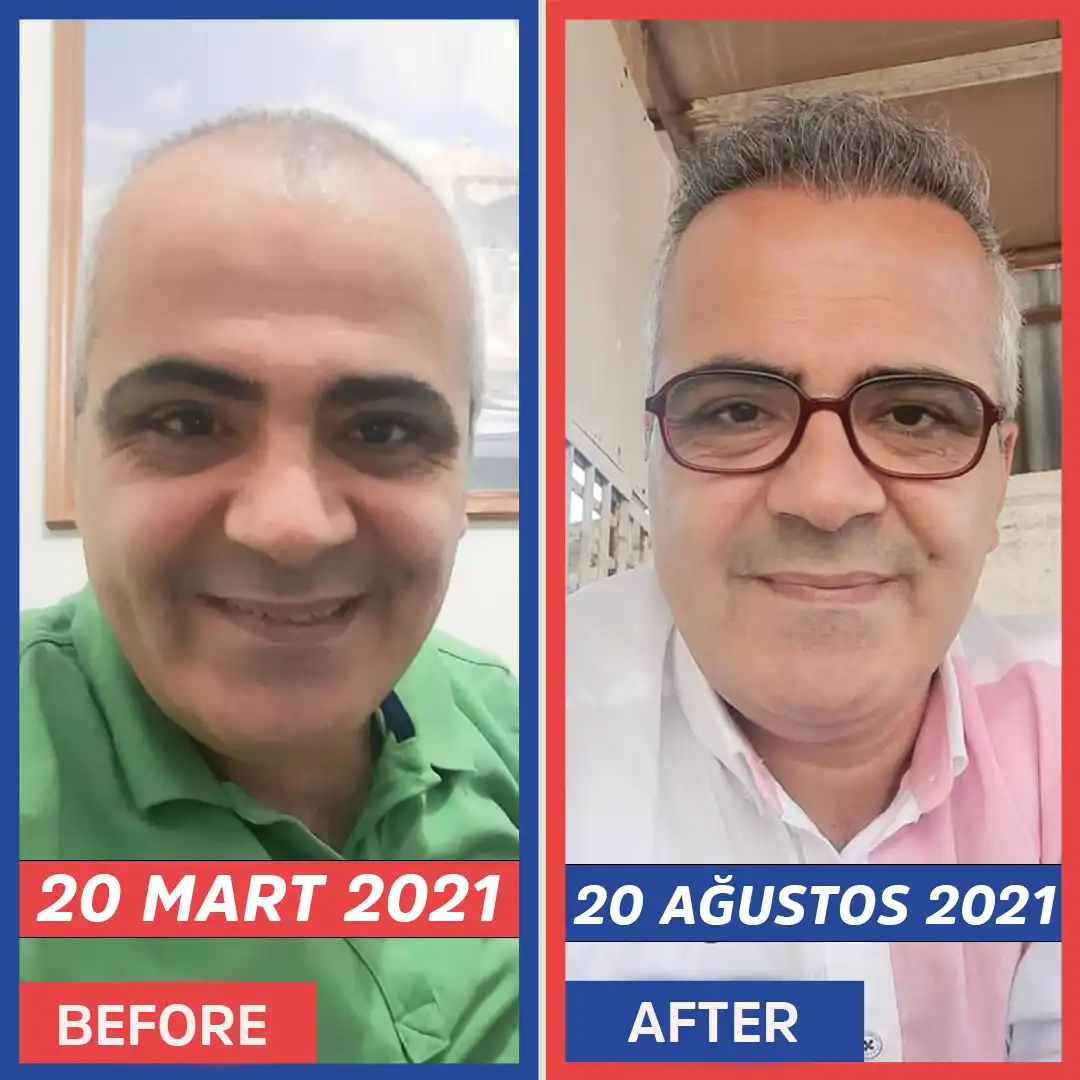
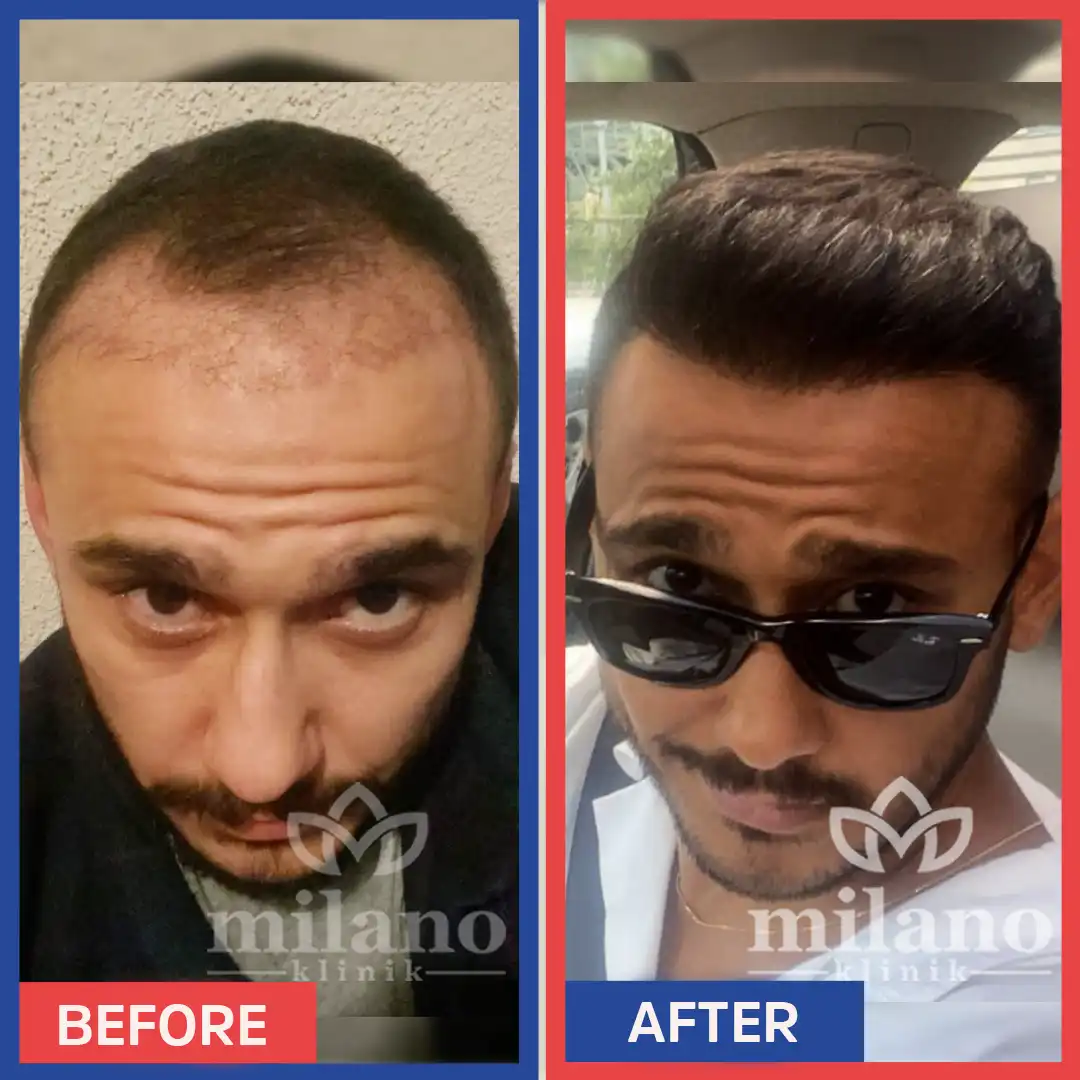
Ideal Candidates for Hair Transplant
Hair transplant is becoming an increasingly popular solution among both men and women worldwide for addressing hair loss and baldness issues. However, not everyone is a suitable candidate for this procedure. We will thoroughly examine who the most suitable individuals for this operation are, the factors determining ideal candidates, and important considerations to be made before undergoing hair transplant.
Type and Stage of Hair Loss
Individuals Experiencing Permanent Hair Loss: Those suffering from permanent hair loss problems due to genetic factors, such as androgenetic alopecia (male pattern baldness), are ideal candidates for hair transplant.
Individuals with Stabilized Hair Loss: People whose hair loss pattern has stabilized and has not changed significantly over a few years are more suitable candidates for hair transplant.
Having Adequate Donor Hair Follicles
Sufficient Donor Area: Hair transplant involves transferring an individual’s own hair follicles to another area. Therefore, having sufficient and healthy donor hair follicles is crucial for the operation.
General Health Condition
Good Health Condition: Since hair transplant is a surgical procedure, individuals in good general health without any chronic diseases are ideal candidates.
Suitability for the Recovery Process: Individuals who can adhere to the post-transplant recovery process and instructions are more suitable candidates for the operation.
Realistic Expectations
Evaluation of Expectations: Hair transplant cannot completely stop hair loss or restore all hair. Individuals with realistic expectations regarding the limitations and potential results of the operation are ideal candidates.
Age Factor
Middle-aged and Older: People in middle age and older, where the pattern of hair loss has become clear and stabilized, are generally more suitable candidates for hair transplant. However, younger individuals may also be deemed suitable after a detailed evaluation.
Special Considerations for Women
Hair Loss in Women: Since female pattern hair loss is generally diffuse, hair transplant in women may require a more complex evaluation. Hair transplant can yield successful results in suitable candidates.
Hair Transplant in Men
Hair transplant in men is a popular operation chosen for the treatment of conditions such as androgenetic alopecia (male pattern baldness), which is widespread among men and develops due to genetic factors. This procedure offers a permanent solution for men experiencing hair loss, aiming to improve their aesthetic appearance, boost their self-confidence, and achieve a rejuvenated look.
Causes of Hair Loss in Men
Hair loss in men typically develops due to factors such as genetic predisposition, aging, hormonal changes, and lifestyle. Androgenetic alopecia is the most common type of hair loss in men and is triggered by genetic susceptibility.
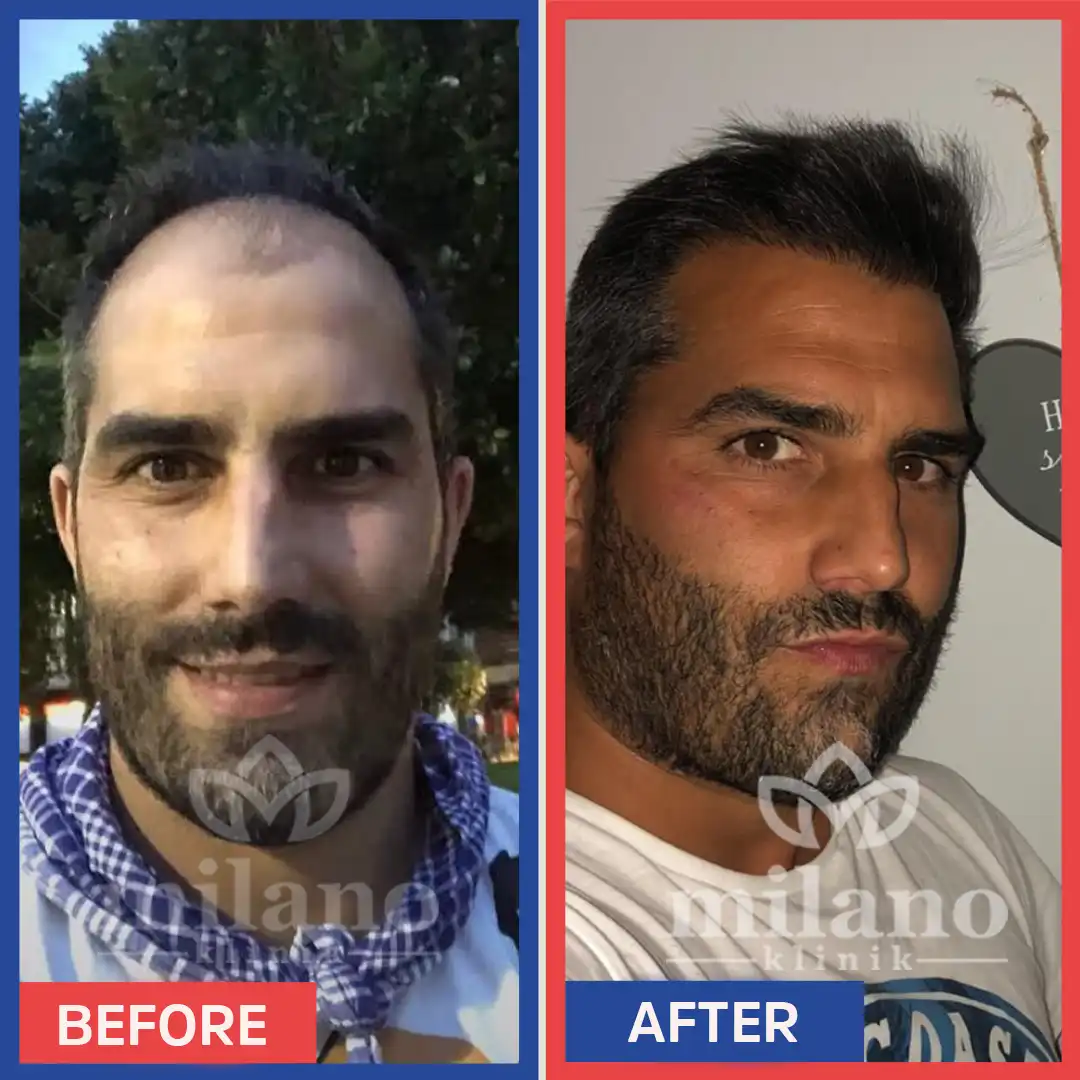
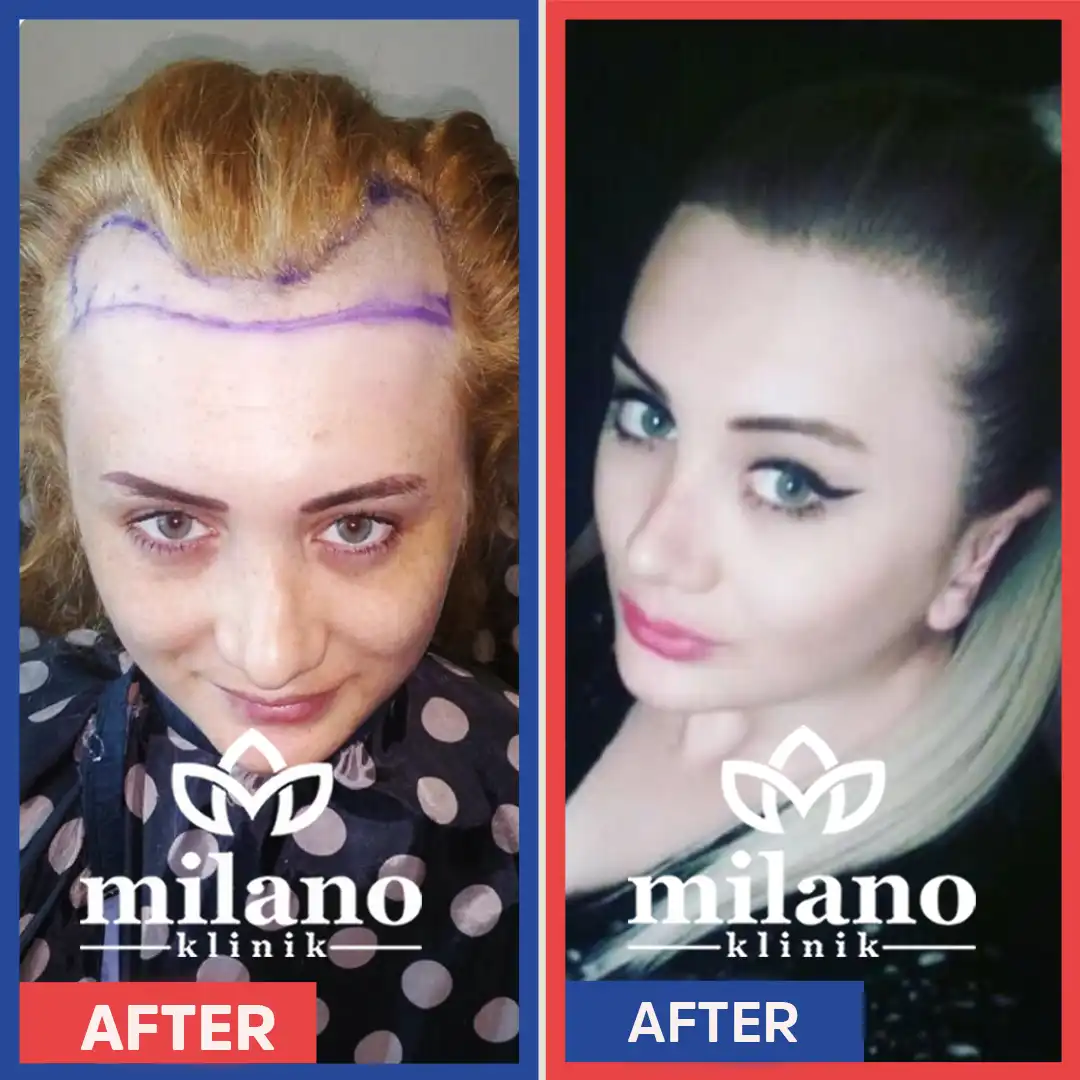
Hair Transplant in Women
Hair transplant in women is becoming an increasingly popular treatment method for solving hair loss and thinning issues. Female pattern hair loss usually arises from factors like genetics, hormonal changes, aging, and various health conditions.
Causes of Hair Loss in Women
Genetic Predisposition: A history of hair loss in the family.
Hormonal Changes: Conditions such as menopause, pregnancy, and polycystic ovary syndrome (PCOS).
Medical Conditions: Health problems like thyroid diseases and iron deficiency anemia.
Stress and Dietary Habits: Severe stress and poor nutrition can lead to hair loss.
Benefits and Advantages of Hair Transplant Surgery
With today’s technological advancements and surgical techniques, hair transplant has become a popular option for both men and women. Under the title “Benefits and Advantages of Hair Transplant Surgery,” we will examine the main benefits this operation provides in detail.
Natural-Looking Results
Naturalness: Modern hair transplant techniques enable the achievement of highly natural-looking results. Hair follicles are transplanted in alignment with the natural growth direction of the hair.
Permanent Solution
Long-Term Benefits: Hair transplant offers a permanent solution against hair loss. Since the transplanted hair follicles are taken from areas resistant to hair loss, the new hair is permanent.
Increased Self-Confidence
Improvement in Appearance: The improvement in hair density and appearance after hair transplant significantly boosts individuals’ self-confidence.
Minimal Scarring
Advanced Techniques: The Follicular Unit Extraction (FUE) method, in particular, leaves almost no scarring and preserves the natural appearance of the hair.
Short Recovery Period
Quick Recovery: Modern hair transplant methods generally require a short recovery period. Patients can return to their daily activities shortly after the operation.
Customized Treatment
Personalized Planning: Hair transplant is customized according to the individual’s pattern of hair loss, hair density, and aesthetic goals.
Wide Application Area
Applicability to Various Areas: Hair transplant is not only applicable for hair loss on the scalp but can also be performed on the beard, mustache, and eyebrows.
Reliability
Safety: Hair transplant operations are risk-free surgical interventions when properly planned and performed by an experienced team.
Improved Quality of Life
Social and Professional Life: The positive aesthetic effects of hair transplant also have favorable reflections on individuals’ social and professional lives.
Alternative to Medical Treatments
Reduction in the Need for Other Treatments: Hair transplant offers an alternative to medical treatments used to prevent or reverse hair loss. Simple hair care routines are sufficient for the maintenance and health of the transplanted hair.
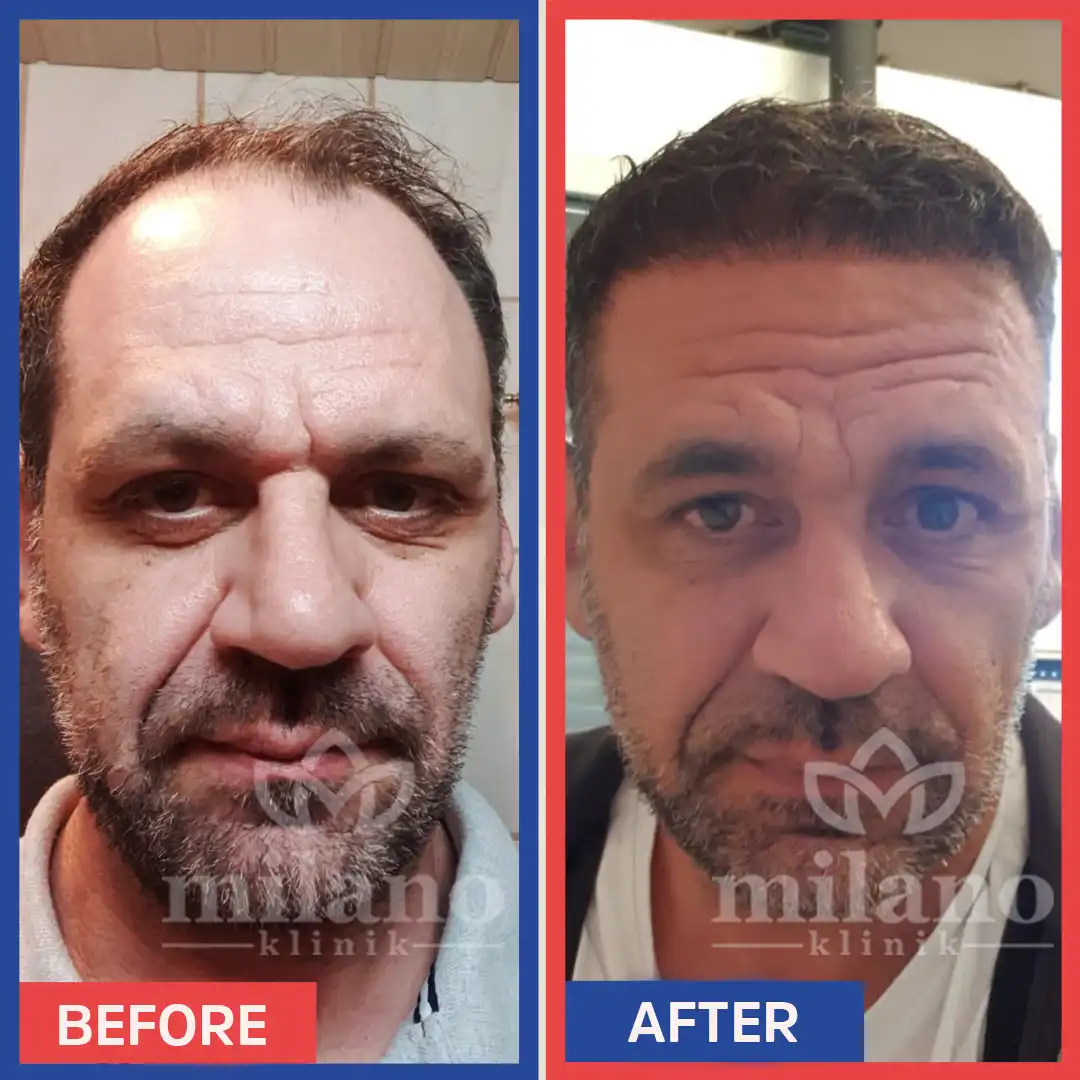
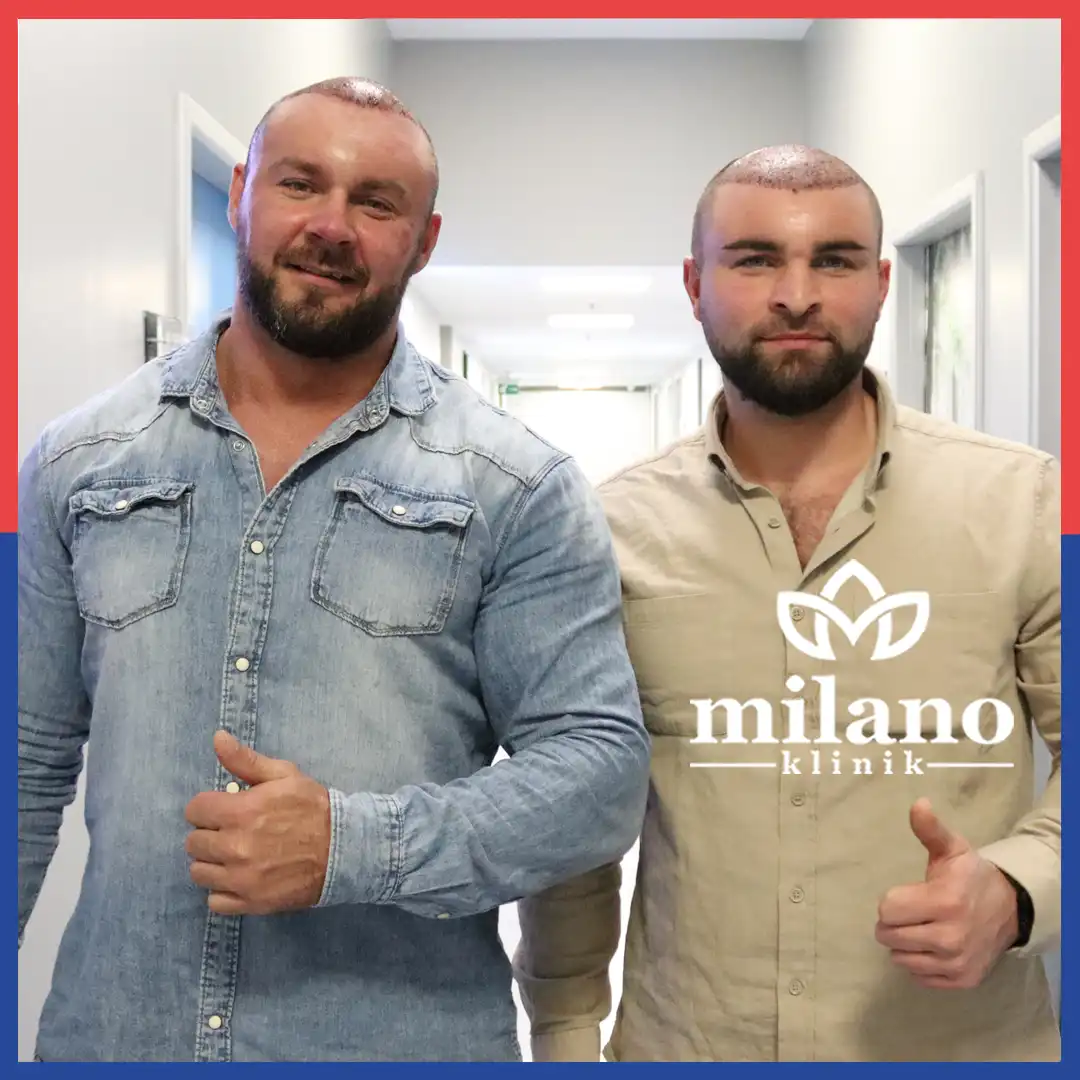
Worldwide Celebrities Who Have Undergone Hair Transplant
Hair transplant is a method chosen by many celebrities who are in the public eye and care about their appearance. Thanks to advanced hair transplant technologies and techniques, numerous well-known figures have selected this permanent solution to combat their hair loss problems. Under the title “Celebrities Who Have Undergone Hair Transplant,” we will examine the world-famous male celebrities who have undergone hair transplant operations and the positive changes this process has created in their lives and careers.
Elon Musk: The CEO of Tesla and SpaceX reversed his early-age hair loss with hair transplant, achieving a fuller hair structure.
Harry Styles: There are speculations that the young singer and actor underwent hair transplant to increase his hair density.
Matthew McConaughey: It is known that the Hollywood actor underwent hair transplant to restore his hairline.
David Beckham: The famous footballer might have undergone hair transplant to increase his hair density.
Tom Brady: The NFL star is among the celebrities speculated to have had a hair transplant, though there is no definitive confirmation.
Paulo Costa: The UFC fighter underwent a hair transplant operation to combat hair loss.
Steve Carell: The actor and comedian experienced a noticeable increase in hair density in the later stages of his career.
Rob Holding: There are reports that the star of the Arsenal football team underwent hair transplantation.
Bradley Cooper: Hollywood’s beloved star might have turned to hair transplant to combat hair loss.
Joel McHale: The comedian and actor underwent hair transplant to strengthen his hair.
Prince Harry: The member of the royal family is speculated to have considered various treatments for hair loss.
Jimmy Carr: The comedian openly stated that he is pleased with the hair transplant he had.
Gordon Ramsay: It is known that the famous chef underwent hair transplant to increase his hair density.
Tristan Tate: The renowned kickboxer and internet phenomenon had a hair transplant.
Conor McGregor: The UFC fighter might have undergone hair transplant to increase his hair density.
Dave Portnoy: The founder of Barstool Sports announced that he had undergone a hair transplant operation.
Rob Brydon: The comedian and actor shared with the public that he had a hair transplant.
Joe Rogan: The podcast star and commentator has talked about his experience with hair transplant at a young age.
Floyd Mayweather: The professional boxer underwent hair and beard transplant.
Chris Evans: The “Captain America” star might have undergone hair transplant to increase his hair density.
Justin Bieber: The young pop star is said to have taken measures against hair loss.
Ben Affleck: The famous actor might have undergone hair transplant to increase his hair density.
Jamie Foxx: There are speculations that the actor and singer underwent hair transplant to improve his hairline.
John Travolta: The Hollywood star achieved a rejuvenated look with hair transplant.
Kevin Costner: The famous actor might have undergone hair transplant to increase his hair density.
Tom Cruise: One of Hollywood’s most recognized faces might have undergone hair transplant to increase his hair density.
The hair transplant experiences of these celebrities play a significant role in increasing the popularity and acceptance of the operation. Hair transplant can provide successful results for everyone with the right assessment and a professional approach.
Turkish Hair Transplant in Istanbul
In recent years, Turkey, particularly Istanbul, has become a global center for hair transplant. Thanks to advanced healthcare services, experienced doctors, and affordable prices, many local and international patients choose this region. Under the title “Turkish Hair Transplant in Istanbul”, let’s explore the hair transplant opportunities in Istanbul and why this city has become such a popular destination.
Experienced Hair Transplant Specialists
Expert Doctors: Istanbul hosts doctors specialized in hair transplant with extensive experience, offering services at international standards.
Use of Advanced Technology
Modern Techniques: Hair transplant clinics employ the most advanced hair transplant techniques, such as FUE (Follicular Unit Extraction) and DHI (Direct Hair Implantation).
Affordable Cost
Cost-Effectiveness: Turkish Hair Transplant in Istanbul offers quality hair transplant operations at much more affordable cost compared to the USA or Europe, making Istanbul an attractive option for international patients.
Comprehensive Service Packages
Service Packages: Many clinics offer comprehensive packages that include accommodation, transfers, and consulting services before and after the hair transplant operation.
Opportunity to Combine Tourism and Treatment
Tourism Opportunities: Turkey offers the chance to combine the treatment process with a vacation experience, thanks to Istanbul’s rich historical and cultural heritage. Patients can explore the beauty of the city before and after their operation.
International Standard Healthcare Services
Quality and Safety: Clinics in Istanbul, Turkey, provide high-quality services in accordance with international health standards and have various international accreditations.
Multidisciplinary Approach
Holistic Evaluation: The turkish hair transplant process is not just a surgical procedure but also requires a holistic assessment and treatment planning for the patient. Clinics in Istanbul adopt this approach.
Ease of Communication
Multilingual Support: Clinics in Istanbul, Turkey, have multilingual staff, allowing patients to communicate in their own languages. This is a significant advantage for international patients.
High Patient Satisfaction Rates
Positive Feedback: Turkey has high patient satisfaction rates in turkish hair transplant. Patients are pleased with the quality of service and the results they achieve.
Possibility of Revisiting
Long-Term Relationships: Many patients prefer to revisit Turkey and Istanbul for check-ups or additional treatments due to their satisfaction with the services received.
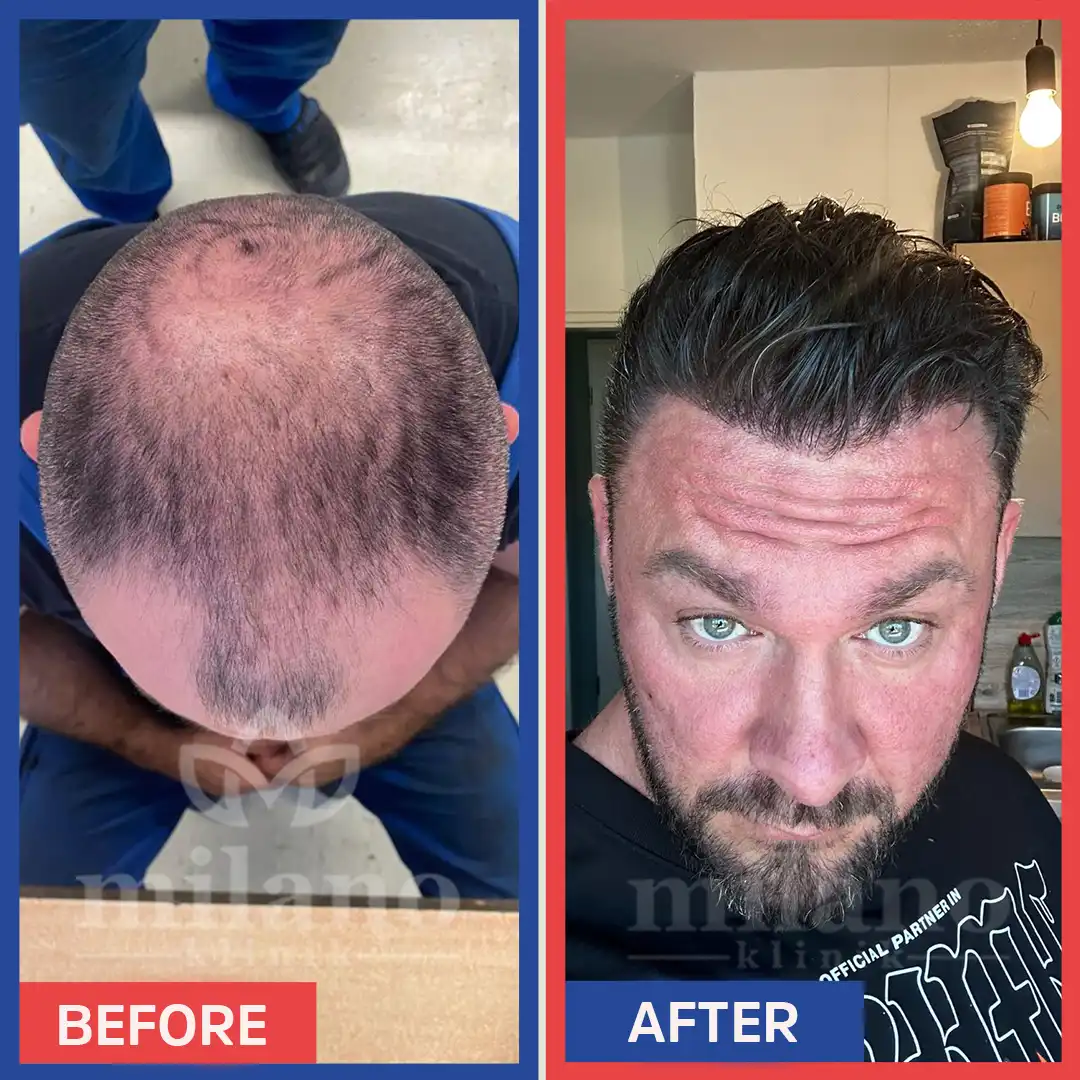
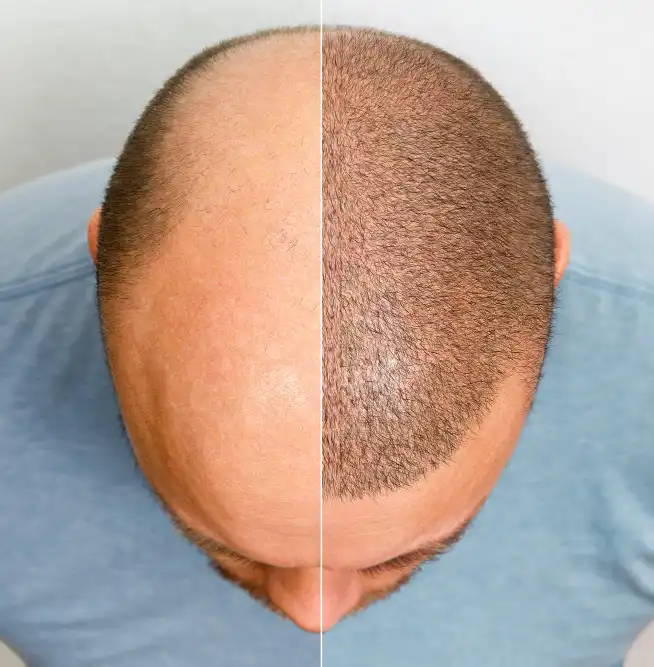
Choosing the Best Hair Transplant Center
The success of a hair transplant largely depends on the quality of the hair transplant center chosen. Under the title “Choosing the Best Hair Transplant Center (Clinic),” we will examine the critical factors to consider when evaluating a hair transplant center.
Experienced and Certified Experts
Expert Doctors: It’s important for the doctors performing the hair transplant to have years of experience in the field and hold certifications with international validity.
Trained Healthcare Staff: The entire team conducting the operation should have received specialized training in hair transplant and be experienced.
Modern Technology and Methods
Current Techniques: The clinic should offer the most up-to-date hair transplant techniques, such as Follicular Unit Extraction (FUE) and Direct Hair Implantation (DHI).
High-Quality Equipment: The equipment used in hair transplant procedures should be modern, sterile, and patient-safe.
Comprehensive Preliminary Evaluation and Consultation
Personalized Planning: Detailed preliminary evaluations should be conducted based on the type and needs of the patient’s hair loss, and personalized treatment plans should be provided.
Transparent Information: Potential risks, the recovery process, and expected results should be clearly and transparently communicated.
Patient Satisfaction and Feedback
Positive Patient Reviews: The satisfaction levels and feedback of patients who have previously undergone treatment at the clinic provide valuable information about the clinic’s quality.
Success Rates: The quality of the results obtained after the hair transplant and the satisfaction rates of the patients.
Sterilization Standards
Health and Safety Protocols: Strict health and safety protocols implemented to protect patients’ health.
Post-operative Care and Support
Post-operation Follow-up: Regular monitoring of the patient’s condition after the hair transplant and provision of necessary support services.
Care Recommendations: Sharing care tips that will accelerate the recovery process and enhance the quality of the results.
Price and Cost Performance
Transparent Pricing: The costs of services should be clearly determined, and patients should be informed about any additional fees in advance.
Price/Performance Balance: The quality of the services provided should be proportional to the price requested.
The selection of the best hair transplant center or clinic should be made by paying attention to the criteria listed above.
Before and After Photos of Hair Transplant
Before and after photos of hair transplant are of great importance for potential patients to visually evaluate the effects of the hair transplant process. These photos not only demonstrate the success and aesthetic outcomes of hair transplant operations but also provide patients with a concrete idea about the craftsmanship of doctors and the quality of the techniques applied. For those considering the hair transplant process, before and after images play a significant role in managing expectations and making informed decisions. These photos, offered by clinics and hair transplant specialists, clearly show the degree of hair loss before treatment and the improvement and increase in hair density after treatment, showcasing the transformative power of hair transplant. Therefore, it is recommended for individuals considering hair transplant to take such visual evidence into account when making their treatment decisions.
Hair Transplant with Reviews from Our Real Guests
Under the title “Hair Transplant with Reviews from Our Real Guests,” we shine a light on the experiences of individuals who have embarked on the hair transplant journey. The real reviews of people who have taken the hair transplant journey provide in-depth information to potential patients about this aesthetic and rejuvenating treatment process. These valuable insights, which serve as an essential resource for those considering hair transplant, offer extensive information on various topics such as pre- and post-operation expectations, the process experienced, the recovery period, and the results achieved. Discover the positive changes created in their lives by the hair transplant operation by reading and watching firsthand the satisfaction of our guests and the self-confidence they gained after treatment. These real-life stories can guide you through your decision-making process regarding hair transplant and offer a realistic perspective on the transformation you anticipate. Follow our Milan Clinic YouTube account to watch our valued guests share their hair transplant journey.
Hair Transplant Surgery Cost
Under the title “Hair Transplant Surgery Prices: Achieve Your Dream Look at Affordable Costs,” we’ll explore the costs of hair transplant treatment and affordable hair transplant options, demonstrating how this aesthetic investment can make achieving your dream appearance possible. We’ll detail the factors affecting hair transplant prices and how to find a cost-effective solution without compromising on quality.
Factors Influencing Cost
Applied Technique: Hair transplant methods (such as FUE, Sapphire, DHI) significantly influence the cost.
Number of Grafted Follicles: Hair transplant prices vary depending on the number of grafts (hair follicles) transplanted. A denser transplant can increase the cost.
Location and Reputation of the Clinic: The country and city where the hair transplant operation is conducted, as well as the prestige of the clinic, also affect the prices.
Affordable Hair Transplant Options
Hair Transplant Packages: Many clinics offer comprehensive packages that include the operation, accommodation, and transfers. These packages provide a cost advantage over purchasing individual services separately.
Seasonal Campaigns and Discounts: Some clinics offer special discounts and campaigns for hair transplant operations during certain periods.
Group Discounts: If you plan to have a hair transplant with your friends or family, you can benefit from group discounts.
Balance Between Cost and Quality
Thorough Research: When evaluating affordable hair transplant options, care should be taken not to compromise on the quality of service. Patient reviews and results should be considered when choosing a clinic.
Transparency: It’s important to receive transparent information from clinics about factors affecting costs and additional services.
Cost Analysis
Total Cost: When assessing the total cost of the hair transplant operation, consider all potential additional costs (accommodation, transportation, medications, etc.) beyond the operation itself.
Conclusion
While it is possible to achieve your dream at reasonable costs, prioritizing the quality of service and the effectiveness of the treatment offered during the hair transplant process is essential alongside the cost. For a quality hair transplant experience, making an informed choice by striking a good balance between costs and services is crucial.
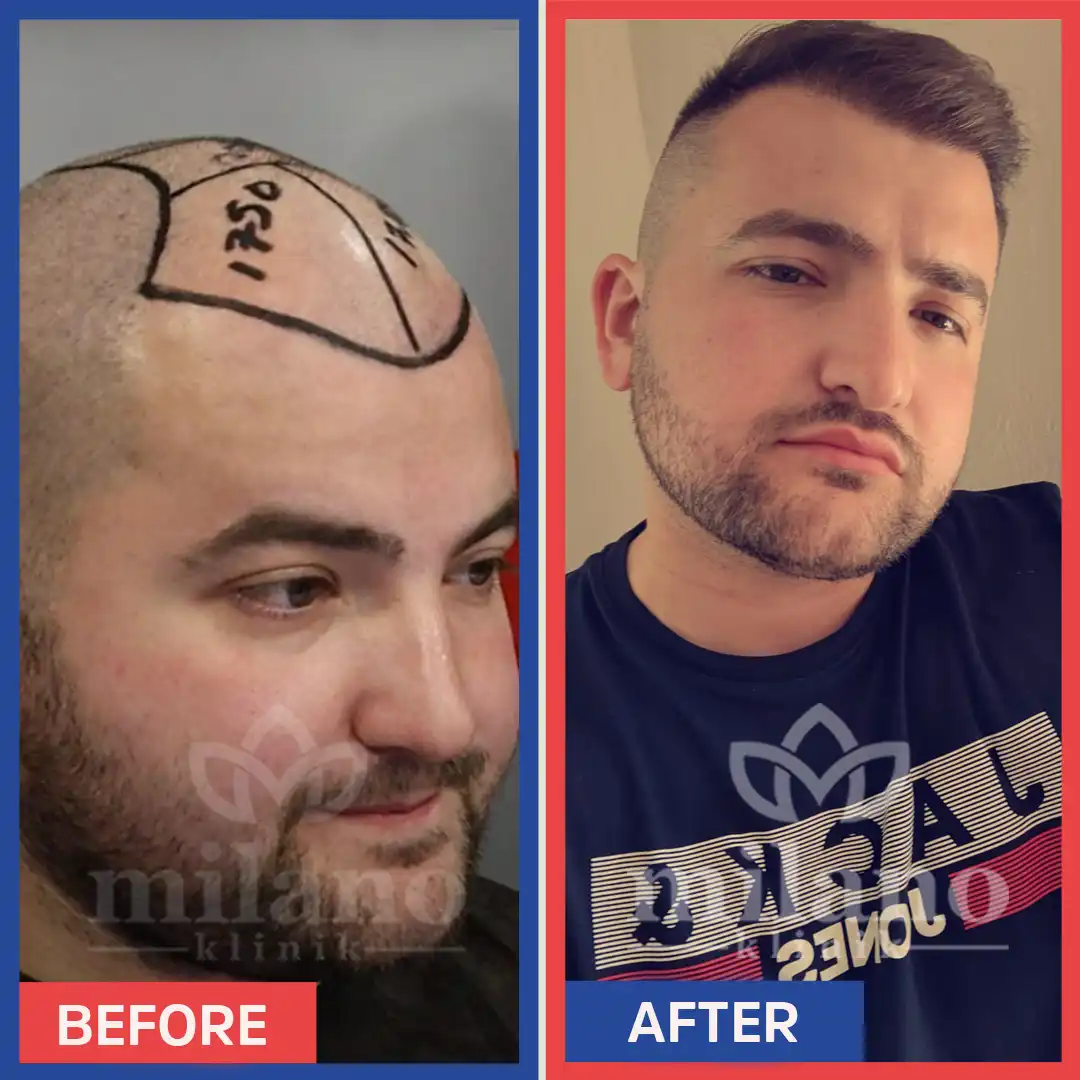
Over 100 Hair Transplant Reviews
Take a look at the reviews of our lovely guests who already have Hair Transplant with Milano Clinic.
Do You Have Questions About Hair Transplant?
Our Medical Experts will answer all your questions about Hair Transplant.

Milano Clinic
Medical Consultant



I am interested in FUE with possible 3500-4000 grafts. I have done my research already. This procedure was recommended by a reputable clinic.
please email me your package and prices. I also need to know the name and level of experience of the doctor who does the procedure.
would i receiver an extra disount if I get My RF Micro needling through your Clinic?